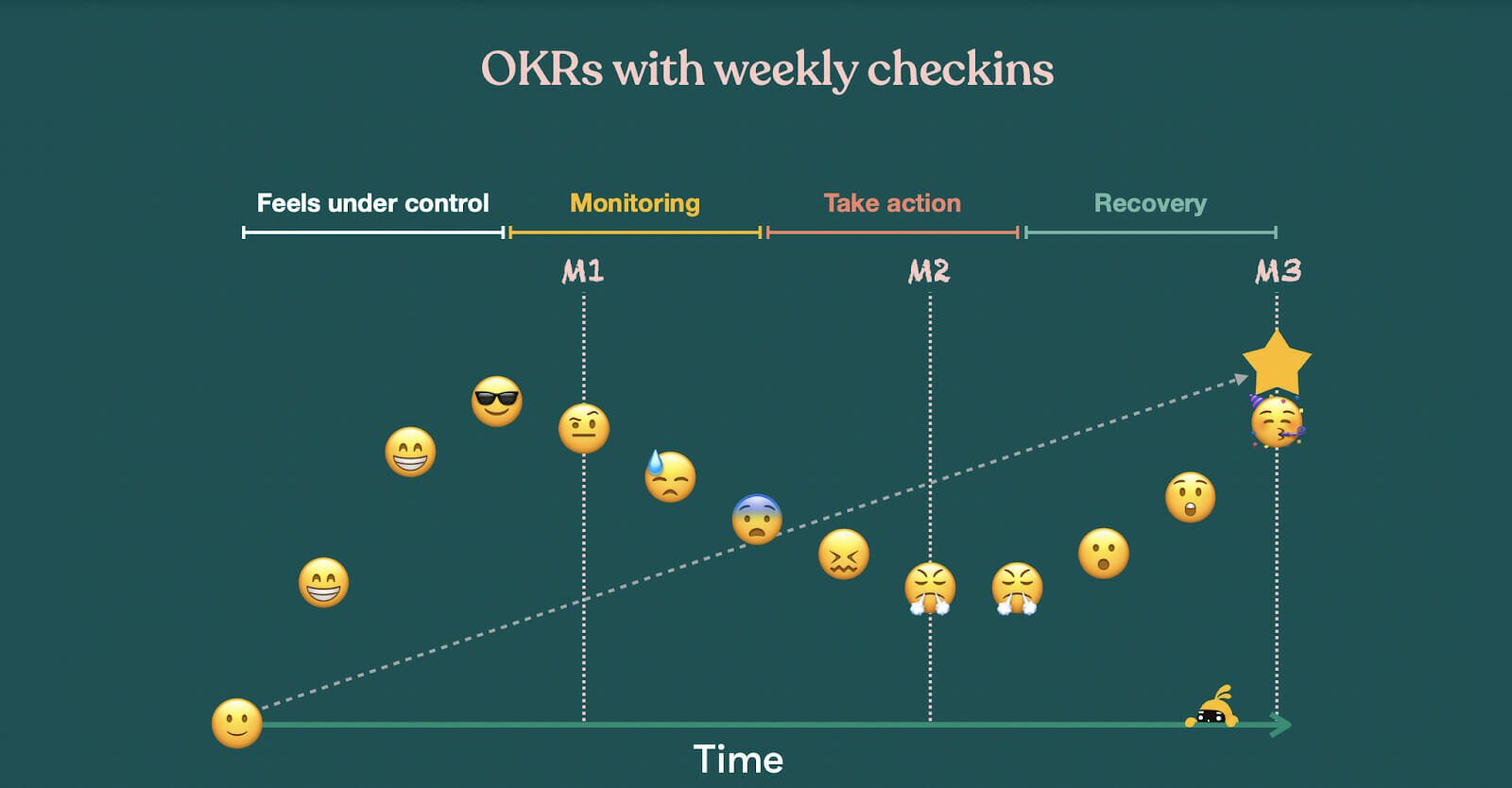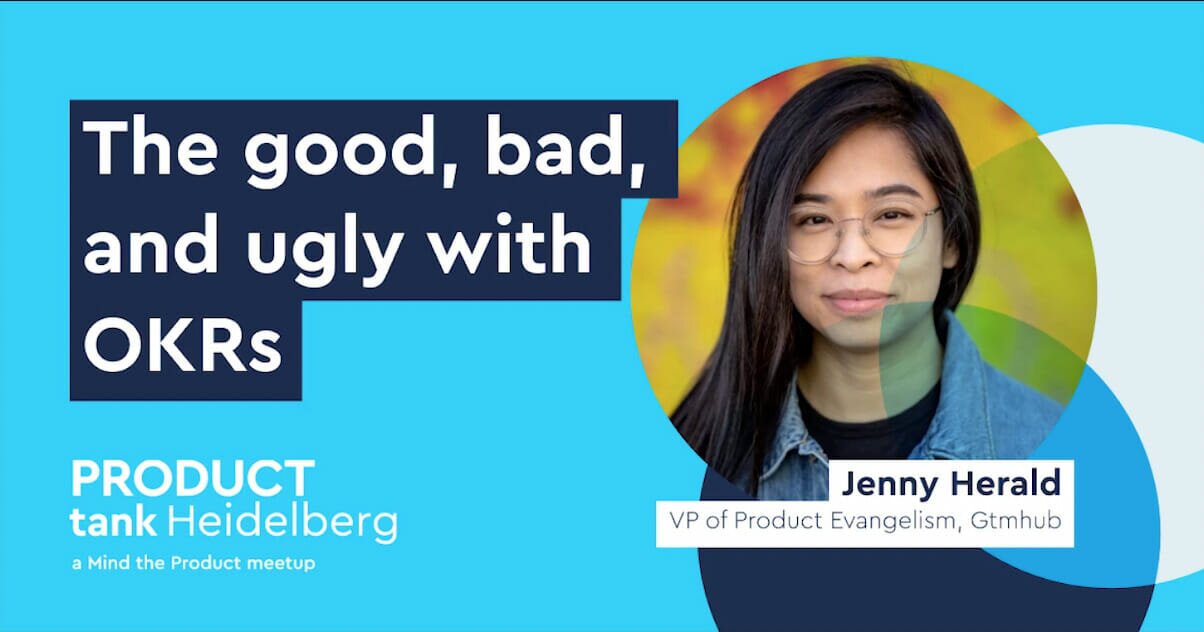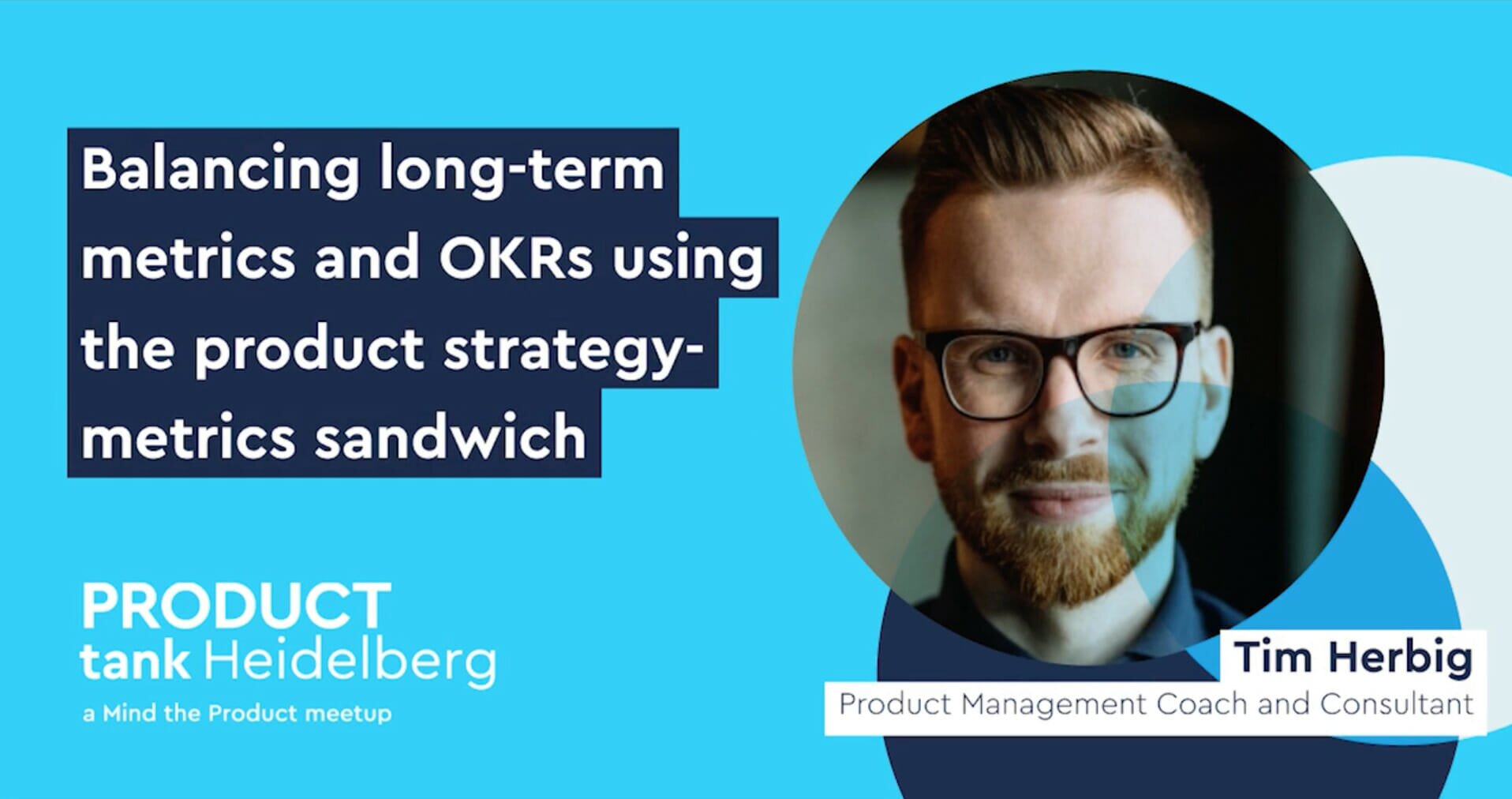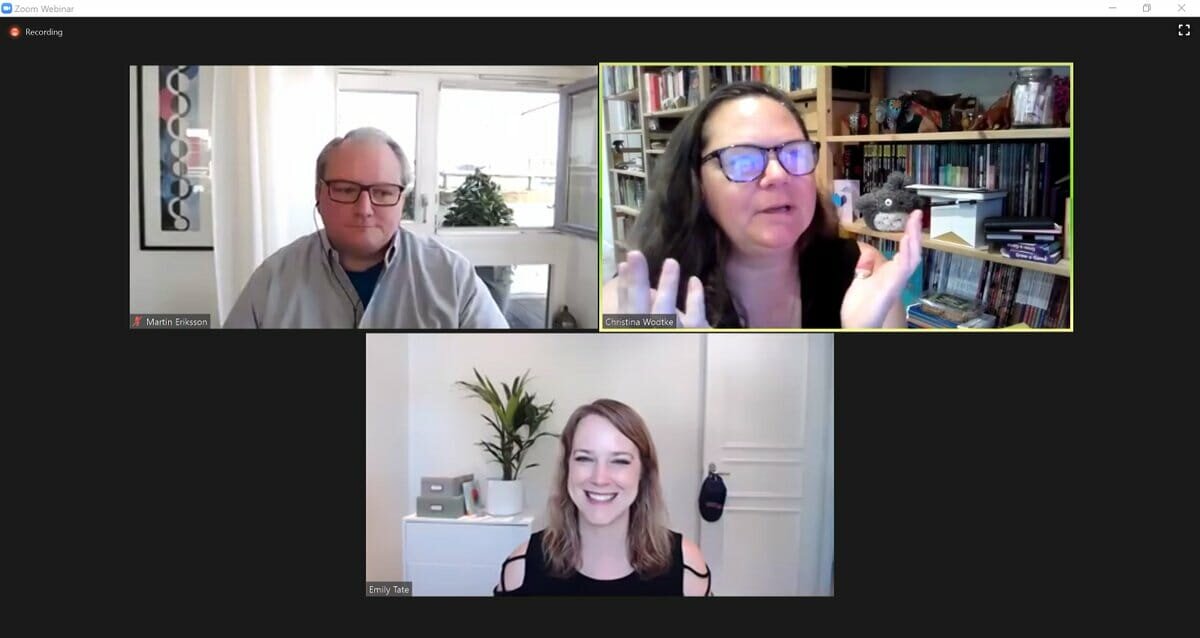Objectives and Key Results (OKRs) are used in different ways depending on company size and industry. What's more, different stages of the framework present different challenges. To shed light on some key areas within the OKR framework, we asked three product managers to share their experiences.
In this post, one reveals their experience of implementing OKRs in a large organisation, another discusses how they ensured transparency for accountable and autonomous working, and our final product manager shares the steps they took to drive real progress using the framework.
Implementing OKRs
If people aren't aligned or if they don't understand what's being asked of them, setting OKRs can be a painful process. Chris Butler, Assistant Vice President, Global Head of Product Operations at multinational IT services and outsourcing consultancy Cognizant, knows this all too well. He found that implementing OKRs for a business of 15,000 employees and a product management team had its challenges.
Common OKRs implementation challenges
In March 2020, Chris joined Cognizant to introduce OKRs across the company. This project was to ensure that all employees at the organisation were aligning and improving cross-collaboration to work towards their common goal of enhancing technology for external companies.
Too many objectives
From the get go, Chris believes that teams don't set too many objectives. “When organisations set too many OKRs, they lose focus on their key goals, and the progress they make is spread thinly across their many objectives. It means that organisations may fail to make a significant dent on any single one.” Chris says, “limiting the number of OKRs to three or four like we encourage teams to do is the first step to implementing this framework.” Additionally, teams needed to get used to the new framework — it required a reshape of culture.
Getting people on board
“Another issue with implementing OKRs is that there needs to be a redistribution of power. There is a constant wave of transformation and mindset shift which is different to what people were used to,” Chis says. Gaining help from team leaders to introduce the framework to their teams is key.
Committing to the framework
OKR implementation needs to be supported by teams and leaders for adoption to be successful, he believes. “Getting commitment from different levels of the organisation was important,” Chris says to show the clear benefits of using OKRs. Use storytelling to reinforce OKR wisdom through videos and interactive presentations.
Educating teams about OKRs
To educate teams about OKRs, Chris has previously run several one-time 30-minute workshops across the whole organisation so that teams can learn and understand some common mistakes, and learn the challenges that come with goal-setting. He also talked them through the history and the full definition of OKRs. After the workshop, he set additional work for leaders, asking them to write mock objectives. He then critiqued these examples to reduce the chance of failure later down the road.
“I called on the leaders who made these mock OKRs and highlighted their mistakes. This was done to ensure that everyone was learning together.” Chris says. “If no one provided feedback on their objectives, then no one would have iterated, and no one would have learned anything constructive.”
Read this blog post by Kim Atherton — OKRs: So simple! So then why isn’t everyone using them?
Tips for successful OKR implementation
To succeed in implementing OKRs, Chris recommends you:
- Start small and quarterly
- Ensure all teams are on board with the framework and have a full understanding of how it works
- Encourage teams to align their OKRs to the overall business strategy
Following these steps will give all teams a good baseline to drive progress and success both within their teams and cross-functionally.
Ensuring transparency
It can be hard for organisations to build and maintain transparency as the team size grows. With fewer teams, smaller organisations are more likely to be transparent, but as the business grows teams will have separate objectives and responsibilities. A solution to maintaining trust and transparency is to use OKRs so that everyone feels responsible, accountable, and aware of business objectives.
Dilip Ramachandran, Chief Product Therapist at software development agency Nimi, has found that it’s much easier for all teams to work together if there is full visibility across the organisation. “Workplace transparency has proven to have long-term success in business so it’s important to further instil this by using OKRs,” Dilip says, “workplace transparency helps to improve morale, creates trust between employers and employees, and lowers stress levels.”
Keeping teams aligned
Dilip was previously a member of the executive team at a financial technology platform Bond. Bond’s business goals included reviving the power of personal banking for its customers and building a personalised experience around users’ needs and preferences. However, these ambitions weren’t as visible among its growing workforce of 60 employees — teams risked becoming disjointed and misaligned later down the line when working towards these goals.
Having joined Bond in May 2020, Dilip was able to install the OKR framework with help from the senior management team. The framework has helped teams to clearly understand business objectives, which has led to trust and transparency increasing among teams and senior management. Since the start of July 2020, senior leaders have also encouraged team members to have more input into business goals. There have been weekly stand-ups to build visibility and make everyone feel involved in the wider organisation.
This experience taught Dilip that, “if you're not setting those objectives and agreeing on what goals to aim for with your teams then you risk being on the road to nowhere”.
Giving teams a voice
“It was and is always important for me to ensure that everyone buys into the framework to drive transparency,” Dilip says. He found that teams needed to discuss their thoughts on OKRs to use the framework effectively. Although the decision to use OKRs at Bond came from senior executives, the wider organisation needed to understand the benefits and feel like they had an input to find the value of using an OKR framework.
To further encourage teams to have a voice, Bond integrated this into its business principles: “Take the time to write down stuff that matters. Be authentic and thoughtful. Share it all — mistakes, learnings, wins and losses. Say what you mean and mean what you say. Don’t say anything behind someone’s back that you would not say to them directly.”
Regular meetings were also key, Dilip found. It was important for every team member to have a voice and be held accountable for their objectives weekly, especially with the team growing at a fast rate.
Aligning teams around objectives
To ensure everyone was on the same page with the business objectives and their understanding of OKRs, Dilip says: “We initially released an OKR template for everyone to use so no one was left in the dark.” The template was distributed to product, engineering, and marketing teams and provided an outline of the number of recommended OKRs to use, the timeframe to work towards when setting objectives, and a notes section for teams to explain why they chose the OKRs. This helped to ensure that everyone was setting OKRs in the same way.
Different teams were also encouraged to share their respective objectives with other groups in the organisation to enforce visibility and cross-collaboration.
Find out how real product teams make OKRs work in this extended report
Tips for ensuring transparency
To make sure your OKR process drives transparency, Dilip suggests you:
- Bring everyone to the table — don’t discount their value
- Provide teams with decision-making autonomy over their OKRs to build trust
- While ensuring autonomy, have regular meetings to build visibility across teams
Driving real progress with OKRs
“One of the dangers of OKRs is becoming too obsessed with the Key Results (KRs) and losing track of the objectives,” says Sten Pittet, CEO at Tability, a company that develops goal-tracking software designed for OKRs, KPIs, and projects. If left to their own devices, teams can chase numbers instead of focusing on what they’re working to achieve. To find the real value in OKRs, organisations must focus on the overall objective and track these goals regularly — a lesson that Sten is regularly educating his team and his customers about.
Maximising the value of weekly check-ins
Like Dilip, Sten finds that regularly aligning teams through weekly check-ins can help them to keep track of their goals and progress.
Since starting his role at his previous organisation, Atlassian, where he worked as a Senior Product Manager from July 2014 to December 2016, Sten used these weekly catch-ups to ensure that his team followed the right objectives. “I always found that at Atlassian, the goal-setting part of OKRs was the most challenging part of the strategy. However, if done right, the goal-tracking was where we found our true value in using this framework,” he says.
“Once you set goals and metrics it can be easy to forget about the customers that these changes affect. In my two years as a Senior Product Manager, I found that when we focused on the customer and how our objectives impacted them always helped to drive our goals forward.”
Sten believes that if you track your OKRs monthly, you won’t have enough data points. “You need to have enough data points that you can identify trends in your Key Results. With monthly-tracked OKRs you'll often get a false sense of security until the second month. Then it's already too late if you're in the red.” Sten says. With weekly goal-tracking, Sten felt more in control of his objectives.
Creating an overarching objective
A key objective for Sten and his team of 35 product managers at Atlassian was to help customers access and use a new HR cloud feature. However they found that engineering and marketing teams weren’t aligned on this objective. “When an organisation is as large as Atlassian, with 7,000 employees, multiple teams, and complex hierarchies, it’s difficult to cross-collaborate and drive progress in your respective section,” he explains. Sten says that OKRs not only create a common objective, but also track whether teams are reaching this goal, and define what projects each individual team is working on to head in the right direction.
Sten found that setting this overarching objective for his small team within the wider organisation, and checking up on this goal was a true catalyst for change. It helped to collectively drive progress as an organisation across all departments that were working on the project. “Checking in on this objective regularly helped us to have everyone on the same page and work towards the same goal, which was at the time, improving accessibility for our new product feature.”
Over time, you’ll be able to track where you are going right or wrong through weekly check-ins, Sten says. If you’re not achieving your overall objective then you can see this through slow or no progress in your KRs. If you’re seeing good results from your KRs but you’re not achieving your objectives, then it’s important to take action with your overall objective and rethink what needs to be realigned.

Keys for success for driving progress
To ensure you're driving progress with your OKRs, Sten recommends that you:
- Have weekly check-ins to track progress with OKRs
- Create a culture of reporting good and bad news to drive progress
- Focus on the Objectives just as much as you focus on the Key Results
- Build objectives that your users and teams care about
So, what is the secret to OKR success?
The key stages of implantation, building transparency, and driving progress are pivotal steps to take when using OKRs. Regular check-ins are a key asset throughout all phases of the framework while creating a culture where all teams feel accountable for their goal-setting and tracking are the keys to success.
Training through workshops and templates is key to improving an organisation's understanding of the framework, as it can be a challenge to utilise the full potential of Objectives and Key Results.
Finally, focus on the Objectives before choosing Key Results to drive real progress. Create objectives that customers and teams care about to create a true catalyst for change.
Explore more OKR content
Integrating OKRs can be a huge asset to aligning teams and reaching business goals. Mind the Product has plenty of other resources to help you think through how to achieve this. Explore more content with a focus on OKRs, or search more topics in our Content A-Z.







